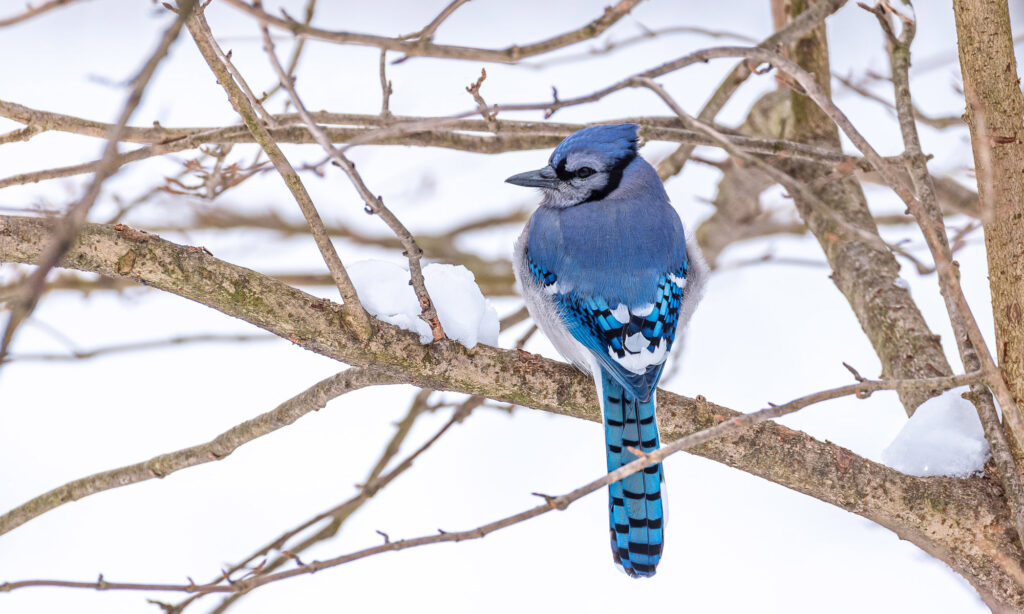THE BLUE JAY BIRD, HABITAT, SOUND, SYMBOLISM, MEANING, PICTURES, FACTS, NEST, HOW TO ATTRACT THEM?
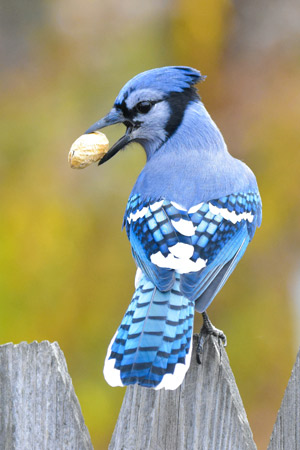
The blue jay (Cyanocitta cristata) is a colorful and vocal member of the corvid family, which also includes crows, ravens, and magpies. They are native to the eastern parts of North America, from Canada to Florida. Blue jays are known for their striking blue plumage, with a crest of feathers on their head that can be raised or lowered, as well as their distinctive blue and white wings and tail.
BLUE JAYS SOUND
One of the most notable characteristics of blue jays is their vocalization. They have a wide variety of calls, including a sharp, clear “jay” sound, as well as a softer “thief” or “fuss-buzz” call. Blue jays also mimic other birds’ calls, such as the red-shouldered hawk, and can even imitate the calls of predators to mislead other birds.
DIET
In terms of diet, blue jays are opportunistic feeders and eat a wide variety of foods, including seeds, fruits, insects, and even small vertebrates. They are also known to cache food, hiding it in various locations to eat later.
NON-MIGRATORY
Blue Jays are generally non-migratory and live in forests, gardens, and suburban areas throughout their range. They are very opportunistic and able to adapt to a variety of environments. Their territoriality is well known, they defend their feeding and nesting sites throughout the year.
INTELLIGENT
Blue jays are also notable for their intelligence. They have been observed using tools, such as using a piece of bark to pry insects out of crevices and have been known to understand the concept of cause and effect. Studies have also shown that blue jays are able to remember the location of food caches for up to several months.
REPRODUCTION
In terms of breeding, blue jays typically mate for life and establish a nesting territory in the spring. The female builds a nest in a tree or bush, usually less than 20 feet off the ground, and lays 3-7 eggs. Both parents help to incubate the eggs and raise the young.
LOCATION
The blue jay is a colorful and vocal bird that is known for its intelligence and adaptability. With its striking plumage and wide variety of calls, it is a familiar and beloved sight and sound in the eastern parts of North America.

IS THE BLUE JAY BIRD AGGRESSIVE?
In addition to their intelligence and adaptability, blue jays are also known for their bold and sometimes aggressive behavior. They will readily defend their territory and food sources and are not afraid to chase away larger birds, such as hawks and crows.
They are also known to aggressively defend their nests during the breeding season, and will not hesitate to attack any perceived threat to their young.
WHAT ARE THEIR FAVORITE TREES?
Blue jays have a symbiotic relationship with several species of trees, particularly oak and pine. They play an important role in the dispersal of acorns and pine seeds by caching them in various locations.
This process helps to ensure that the seeds will have a greater chance of germinating and growing into mature trees. In return, the trees provide food and habitat for the jays, their predators, and many other species.
HOW TO ATTRACT BLUE JAYS?
Despite their aggressive behavior and tendency to raid bird feeders, many people enjoy having blue jays in their backyard.
They can be attracted to bird feeders with sunflower seeds, peanuts, and suet. Blue Jays are also known to visit backyard bird baths and can be observed enjoying a refreshing dip.
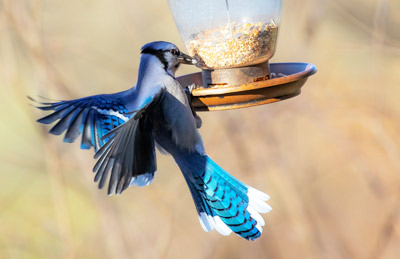
IS THERE A DECLINE IN BLUE JAY?
In recent years, there have been concerns about the decline of blue jay populations. Loss of suitable habitat and increased competition for food sources are believed to be major contributing factors.
Climate change and pesticides are also thought to be affecting their populations. Conservation efforts such as protecting and restoring natural habitats and reducing pesticide use can help to ensure the survival of this beloved species.
The blue jay is an intelligent, adaptable, and colorful bird that plays an important role in the ecosystem. Its striking plumage and a wide variety of calls make it a familiar and beloved sight and sound in the eastern parts of North America.
However, due to habitat loss, food competition, and pesticides, their populations have been decreasing and Conservation efforts are needed to preserve these birds.
CULTURAL
In addition to their role in the ecosystem, blue jays also have cultural and symbolic significance. They have been featured in various forms of art, literature, and folklore throughout the years.
In Native American folklore, the blue jay is often seen as a trickster or mischief-maker, due to its bold and sometimes aggressive behavior.
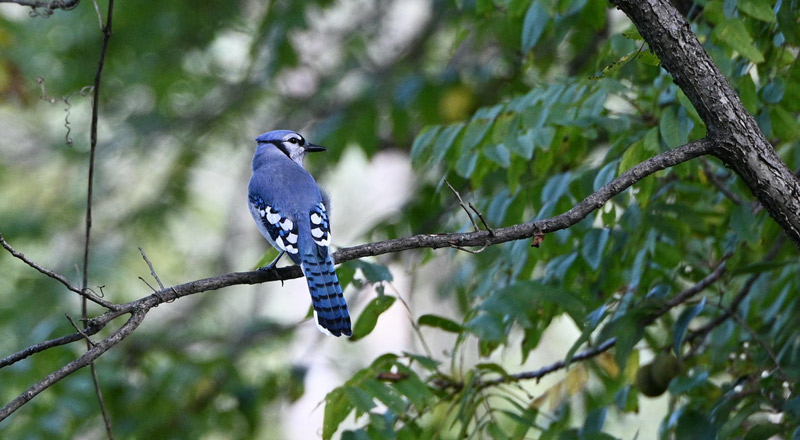
SYMBOL OF BLUE JAY
In modern times, blue jays have become popular as a symbol of strength, confidence, and intelligence. Their bright blue plumage is often associated with clarity of thought, and their ability to mimic other birds’ calls is seen as a symbol of communication and adaptability.
SIGNIFICATION
However, their significance is not just limited to their physical characteristics, Blue Jays hold significance for some people for more personal reasons. For many people Blue Jays hold sentimental value, reminding them of their childhood or a place they used to live. Their calls can evoke memories and a sense of nostalgia.
IMPORTANT ROLE
Despite their bold and sometimes aggressive behavior, blue jays are a beloved species that play an important role in the ecosystem and have cultural and symbolic significance. They are a valuable part of the biodiversity of North America and should be protected and preserved for future generations to enjoy. Habitat conservation, reduction of pesticides, and bird-friendly backyard landscaping are all ways that individuals can help to support blue jay populations.
CONSERVATION
While conservation efforts are important for the survival of the blue jay population, it is also important to understand the behavior and biology of these birds to coexist with them in a way that is beneficial for both humans and blue jays.
For example, in suburban and urban areas, it is often common for Blue Jays to raid bird feeders and eat birdseed meant for other species. To discourage this behavior, it is possible to provide Blue Jays with their own food sources such as peanuts, sunflower seeds, or mealworms in a separate feeder.
HOW TO HELP THE BLUE JAYS?
Another way to coexist with the blue jay is by planting native trees and shrubs in your backyard. As mentioned earlier, Blue Jays play an important role in the dispersal of acorns and pine seeds by caching them in various locations, thus supporting the growth of these trees.
It is also important to consider the use of pesticides in your backyard as these can harm not only blue jay birds but also other wildlife and beneficial insects. Organic gardening methods or integrated pest management can be used as an alternative to harmful chemicals.
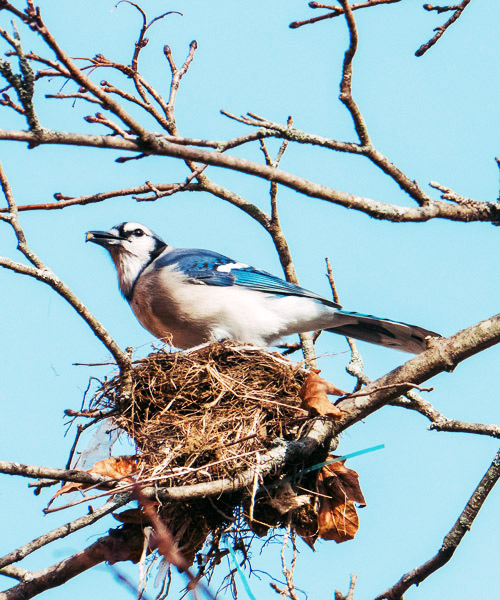
WHEN IS THE BLUE JAY BREEDING SEASON?
It is also important to be aware of the blue jay breeding season which typically occurs between April and June, during this time blue jays can become particularly territorial and may attack perceived threats to their nests.
By understanding the natural behavior of these birds and taking simple steps to accommodate their needs, it is possible to coexist with blue jays in a way that benefits both humans and blue jays.
SOCIAL BEHAVIOUR
Another aspect of blue jays that is worth mentioning is their social behavior. Blue jays are known to form flocks during non-breeding season, where several individuals will come together to forage for food, roost and migrate together.
These flocks can consist of dozens of individuals and are a common sight in the winter months. During the breeding season, blue jays establish a territory and pair up with a mate, typically remaining monogamous for the duration of the season.
COOPERATIVE BREEDING
Interestingly, Blue jays have been observed to engage in cooperative breeding, where they will help to raise the young of a pair of birds that they are not mated to, this behavior has been observed in both wild and captive populations. The helpers are typically non-breeding adults, and their role typically includes feeding the chicks and taking care of the nest.
This type of behavior is relatively uncommon in birds and is thought to be a way for the helpers to increase their chances of producing offspring in the future.
PROBLEM-SOLVING SKILLS
Additionally, blue jays are known to have a strong ability to problem solve and have been observed performing some rather complex tasks, such as solving puzzles, discriminating between quantities, and even using tools.
These cognitive abilities have been attributed to the large and complex avian brain, which is relatively similar in structure to the human brain.
In conclusion, blue jays are a fascinating bird species that have much to offer in terms of their behavior, biology, and ecological importance. Their striking plumage, intelligence, adaptability, and social behavior make them a beloved species in North America. However, it is essential to understand their behavior and take steps to coexist with blue jays in a way that benefits both humans and the blue jays. Conservation efforts such as habitat protection, reducing pesticide use, and providing food and nesting sites can help support and sustain the blue jay population. And by understanding their behavior, we can enjoy the presence of these amazing birds in our backyard while also helping to protect them.


